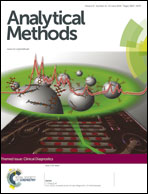SiO2 nanoparticles and diphenylcarbazide doped polymethylmethacrylate electrospun fibrous film for Cd2+ colorimetric detection†
Abstract
Based on the formation of a red [Cd-diphenylcarbazide] complex, a simple and visible method for Cd2+ colorimetric detection was developed by doping SiO2 nanoparticles and diphenylcarbazide in polymethylmethacrylate electrospun fibers. Benefiting from the large surface area due to the addition of SiO2 nanoparticles, the color of the fibrous film changed clearly even in the presence of extremely low concentrations of Cd2+. The detection limit was found to be 1 × 10−8 M. Investigation of the selectivity of the fibrous film on the detection of various metal ions showed that only Cd2+ could induce a yellow-to-red color change. The results demonstrated that SiO2 and diphenylcarbazide doped polymethylmethacrylate fibrous films could act as highly selective strips for the detection of Cd2+ with little interference from other metal ions.


 Please wait while we load your content...
Please wait while we load your content...